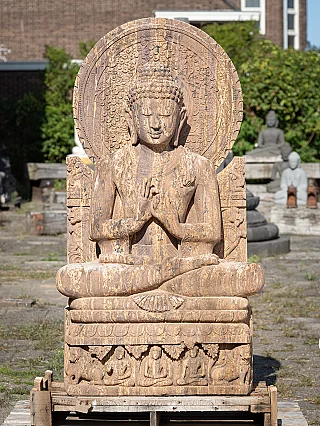Understanding Dharmachakra Mudra

See our Buddha statues with Dharmachakra mudra
Buddha statues, revered for their serene countenances and symbolic gestures known as mudras, serve as profound embodiments of Buddhist teachings. The Dharmachakra mudra occupies a central place among these gestures, symbolizing the momentous occasion in Buddha's life when he delivered his first sermon after attaining enlightenment in Sarnath.
Meaning and Symbolism

The Dharmachakra mudra, translated as the Gesture of Teaching of the Wheel of Dharma, encapsulates fundamental Buddhist principles. It signifies the commencement of the wheel of Dharma, representing the continuous cycle of teachings that guide practitioners on the path to enlightenment. This mudra is not merely a physical gesture but a metaphysical symbol imbued with profound significance in Buddhist philosophy.
Gestural Depiction
When performing the Dharmachakra mudra, Buddha's hands assume a specific posture: each hand's thumb and index finger touch to form a circle, symbolizing the Wheel of Dharma. This circle represents the eternal and unending nature of Buddha's teachings. The right-hand faces outward, while the left-hand covers it with the palm facing inward, symbolizing the transmission of wisdom and compassion.
Each finger in this mudra carries a symbolic meaning:
- The middle finger of the right hand symbolizes those who hear and understand Buddha's teachings, known as the 'hearers.'
- The index finger represents those who realize the truth of his teachings, known as the 'realizers.'
- The little finger signifies the Mahayana, or 'the great vehicle,' emphasizing Buddhist teachings' inclusive and expansive nature.
Similarly, the three extended fingers of the left hand symbolize the Three Jewels of Buddhism: the Buddha (the teacher), the Dharma (the teachings), and the Sangha (the community of practitioners).
Metaphysical Significance
Beyond its physical depiction, the Dharmachakra mudra holds deep metaphysical significance. It embodies the union of method (Upaya) and wisdom (Prajna), which are essential in pursuing enlightenment. By positioning the hands in front of the heart or the left side of the chest, the mudra signifies teachings emanating directly from Buddha's compassionate heart, underscoring the sincerity and purity of his teachings.
Variants and Depictions

Throughout history and across different regions, the Dharmachakra mudra has evolved into various forms, each influenced by cultural and artistic traditions:
- Ajanta Frescoes: In ancient Indian art, such as the Ajanta frescoes, the Dharmachakra mudra is depicted with the hands separated and fingers not touching. This artistic variation highlights regional interpretations and nuances prevalent in Indian Buddhist art.
- Gandhara Style: Indo-Greek statues from the Gandhara region depict Buddha uniquely, where the right fist overlooks the joined fingers of the left hand. This blend of Hellenistic and Indian artistic traditions reflects the cultural synthesis and artistic expression prevalent in Gandharan Buddhist art.
- Horyu-ji Style: In Japanese Buddhist art, particularly in the statues of Horyu-ji temple, the Dharmachakra mudra is portrayed with the right hand overlapping the left. This depiction underscores the adaptation of Buddhist iconography in East Asian cultures, emphasizing spiritual continuity and reverence.
Cultural Spread and Legacy
The symbolism of the Dharmachakra mudra transcends geographical boundaries, illustrating the universal appeal and enduring relevance of Buddha's teachings. From the intricately carved caves of Ajanta in India to the serene gardens of Japanese temples, this mudra has resonated through centuries, inspiring diverse cultures and fostering spiritual contemplation.
Artistic Representation
The artistic representation of the Dharmachakra mudra reflects not only spiritual ideals but also the mastery of craftsmanship in Buddhist art. Sculptors and artisans across Asia have imbued Buddha statues with exquisite detail, capturing the essence of enlightenment and compassion in every gesture.
Philosophical Insights
Philosophically, the Dharmachakra mudra invites contemplation on the dual aspects of Buddhist teachings: method (Upaya) and wisdom (Prajna). It symbolizes the harmonious integration of compassionate action with profound insight, guiding practitioners on the noble path toward liberation and enlightenment.
Modern Interpretations
In contemporary times, the Dharmachakra mudra inspires artists, scholars, and practitioners alike. Its depiction in modern Buddhist art and literature underscores its timeless significance and relevance in today's world, where seekers of truth and wisdom draw inspiration from Buddha's teachings.
Conclusion
The Dharmachakra mudra is a timeless symbol of Buddha's teachings, embodying the essence of wisdom, compassion, and enlightenment. Its depiction in Buddha statues across diverse cultures and epochs reflects Buddhist philosophy's universal appeal and enduring legacy. By understanding the profound symbolism behind the Dharmachakra mudra, we deepen our appreciation for the rich heritage of Buddhist art and philosophy, fostering spiritual contemplation and cultural understanding in today's globalized world.
Share this page






































